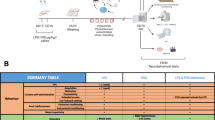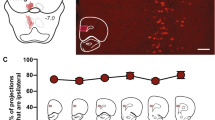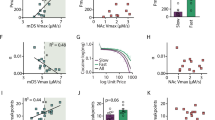Abstract
These experiments tested the hypothesis that pretreatment with a behaviorally sensitizing regimen of cocaine alters the ability of cocaine to disrupt prepulse inhibition (PPI). Male Sprague-Dawley rats were treated with cocaine (30 mg/kg, i.p.) or saline vehicle for seven consecutive days followed by challenge treatment seven days later. Repeated cocaine treatment produced sensitization of stereotyped activity. Cocaine challenge following repeated vehicle treatment significantly reduced PPI, but this effect was completely abolished by repeated cocaine treatment. These data suggest that neuroadaptation following repeated treatment might prevent PPI disruption caused by psychomotor stimulants.
Similar content being viewed by others
Log in or create a free account to read this content
Gain free access to this article, as well as selected content from this journal and more on nature.com
or
References
Byrnes JJ, Pantke MM, Onton J, Hammer RP . (2000): Chronic inhibition of nitric oxide synthase in the ventral tegmental area attenuates cocaine-mediated motor behavior in rats. Prog Neuro Psychopharmacol Biol Psychiatry (in press).
Druhan JP, Geyer MA, Valentino RJ . (1998): Lack of sensitization to the effects of d-amphetamine and apomorphine on sensorimotor gating in rats. Psychopharmacology 135: 296–304
Ellison G . (1994): Stimulant-induced psychosis, the dopamine theory of schizophrenia, and the habenula. Brain Res Rev 19: 223–239
Henry DJ, Hu XT, White FJ . (1998): Adaptations in the mesoaccumbens dopamine system resulting from repeated administration of dopamine D1 and D2 receptor-selective agonists: Relevance to cocaine sensitization. Psychopharmacology 140: 233–242
Henry DJ, White FJ . (1991): Repeated cocaine administration causes persistent enhancement of D1 dopamine receptor sensitivity within the rat nucleus accumbens. J Pharmacol Exp Ther 258: 882–890
Kalivas PW, Stewart J . (1991): Dopamine transmission in the initiation and expression of drug- and stress-induced sensitization of motor activity. Brain Res Rev 16: 223–244
Mansbach RS, Geyer MA, Braff DL . (1988): Dopaminergic stimulation disrupts sensorimotor gating in the rat. Psychopharmacology 94: 507–514
Martinez ZA, Ellison GD, Geyer MA, Swerdlow NR . (1999): Effects of sustained cocaine on sensorimotor gating of startle in rats. Psychopharmacology 142: 253–260
Mutschler NH, Miczek KA . (1998): Withdrawal from i.v. cocaine “binges” in rats: Ultrasonic distress calls and startle. Psychopharmacology 135: 161–168
Nestler EJ, Terwilliger RZ, Walker JR, Sevarino KA, Duman RS . (1990): Chronic cocaine treatment decreases levels of the G protein subunits Gi and Go in discrete regions of rat brain. J Neurochem 157: 53–56
Pierce RC, Bell K, Duffy P, Kalivas PW . (1996): Repeated cocaine augments excitatory amino acid transmission in the nucleus accumbens only in rats having developed behavioral sensitization. J Neurosci 16: 1550–1560
Robinson TE, Becker JB . (1986): Enduring changes in brain and behavior produced by chronic amphetamine administration: A review and evaluation of animal models of amphetamine psychosis. Brain Res Rev 11: 157–198
Sarnyai Z . (1998): Neurobiology of stress and cocaine addiction. Studies on corticotropin-releasing factor in rats, monkeys, and humans. Ann NY Acad Sci 851: 371–387
Subramaniam S, Lucki I, McGonigle P . (1992): Effects of chronic treatment with selective agonists on the subtypes of dopamine receptors. Brain Res 571: 313–322
Swerdlow NR, Braff DL, Taaid N, Geyer MA . (1994): Assessing the validity of an animal model of deficient sensorimotor gating in schizophrenic patients. Arch Gen Psychiatry 51: 139–154
Swerdlow NR, Caine SB, Geyer MA . (1992): Regionally selective effects of intracerebral dopamine infusion on sensory gating of the startle reflex in rats. Psychopharmacology 108: 189–195
Taylor MK, Ison JR, Schwarzkopf SB . (1995): Effects of single and repeated exposure to apomorphine on the acoustic startle reflex and its inhibition by a visual prepulse. Psychopharmacology 120: 117–127
Zhang J, Engel JA, Soderpalm B, Svensson L . (1998): Repeated administration of amphetamine induces sensitization to its disruptive effect on prepulse inhibition in the rat. Psychopharmacology 135: 401–406
Acknowledgements
This work was supported by USPHS Awards DA09822 (RPH) and MH19924 (JJB). The authors wish to thank Horacio Daubon and Dwight Dishmon, who were supported by HL07785, for expert assistance, and Dr. S. Barak Caine for his helpful consultation.
Author information
Authors and Affiliations
Rights and permissions
About this article
Cite this article
Byrnes, J., Hammer, R. The Disruptive Effect of Cocaine on Prepulse Inhibition Is Prevented by Repeated Administration in Rats. Neuropsychopharmacol 22, 551–554 (2000). https://doi.org/10.1016/S0893-133X(99)00151-7
Received:
Revised:
Accepted:
Issue date:
DOI: https://doi.org/10.1016/S0893-133X(99)00151-7
Keywords
This article is cited by
-
Baseline prepulse inhibition of the startle reflex predicts the sensitivity to the conditioned rewarding effects of cocaine in male and female mice
Psychopharmacology (2018)
-
The effects of kappa-opioid receptor ligands on prepulse inhibition and CRF-induced prepulse inhibition deficits in the rat
Psychopharmacology (2010)
-
Contributions of Dopamine D1, D2, and D3 Receptor Subtypes to the Disruptive Effects of Cocaine on Prepulse Inhibition in Mice
Neuropsychopharmacology (2008)
-
Repeated quinpirole treatments produce neurochemical sensitization and associated behavioral changes in female hamsters
Psychopharmacology (2006)
-
Repeated Quinpirole Treatment Increases cAMP-Dependent Protein Kinase Activity and CREB Phosphorylation in Nucleus Accumbens and Reverses Quinpirole-Induced Sensorimotor Gating Deficits in Rats
Neuropsychopharmacology (2004)



